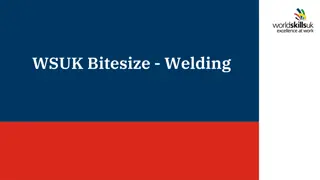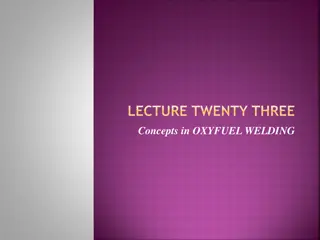Understanding the Fundamentals of Welding Processes
Welding is a materials joining process that involves coalescing two or more parts at their contacting surfaces using heat and/or pressure. It is commonly associated with metal parts, but also used for joining plastics. The advantages include providing a permanent joint and being cost-effective, while disadvantages include manual operations, safety risks, and quality defects. Various types of joints and weld types are essential aspects of welding processes.
Download Presentation

Please find below an Image/Link to download the presentation.
The content on the website is provided AS IS for your information and personal use only. It may not be sold, licensed, or shared on other websites without obtaining consent from the author. Download presentation by click this link. If you encounter any issues during the download, it is possible that the publisher has removed the file from their server.
E N D
Presentation Transcript
Lecture sixteen Fundamental of Welding processes
Introduction Welding is a materials joining process in which two or more parts are coalesced at their contacting surfaces by a suitable application of heat and/or pressure. Many welding processes are accomplished by heat alone, with no pressure applied; others by a combination of heat and pressure; and still others by pressure alone, with no external heat supplied. In some welding processes a filler material is added to facilitate coalescence. The assemblage of parts that are joined by welding is called a weldment. Welding is most commonly associated with metal parts, but the process is also used for joining plastics.
Advantages of Welding Process Welding provides a permanent joint. The welded joint can be stronger than the parent materials if a filler metal is used and if proper welding techniques are used.. Welding is usually the most economical way to join components. Welding is not restricted to the factory environment.
Disadvantages of Welding Processes Most welding operations are performed manually and are expensive. Most welding processes are inherently dangerous. Since welding accomplishes a permanent bond between the components, it does not allow for convenient disassembly. The welded joint can suffer from certain quality defects that are difficult to detect.
Types Of Joints There are five basic types of joints for bringing two parts together for joining. The five joint types are not limited to welding; they apply to other joining and fastening techniques as well. With reference to Figure 16.1., the five joint types can be defined as follows: a. Butt joint. In this joint type, the parts lie in the same plane and are joined at their edges. b. Corner joint. The parts in a corner joint form a right angle and are joined at the corner of the angle. c. Lap joint. This joint consists of two overlapping parts. d. Tee joint. In a tee joint, one part is perpendicular to the other in the approximate shape of the letter T. e. Edge joint. The parts in an edge joint are parallel with at least one of their edges in common, and the joint is made at the common edge(s).
Types Of Joints Figure 16.1
Weld Types A fillet weld is used to fill in the edges of plates created by corner, lap, and tee joints, as in Figure 16.2. Filler metal is used to provide a cross section approximately the shape of a right triangle. It is the most common weld type in arc and oxyfuel welding because it requires minimum edge preparation the basic square edges of the parts are used. Fillet welds can be single or double (i.e., welded on one side or both) and can be continuous or intermittent (i.e., welded along the entire length of the joint or with unwelded spaces along the length).
Weld Types Figure 16.2
Groove welds usually require that the edges of the parts be shaped into a groove to facilitate weld penetration. The grooved shapes include square, bevel, V, U, and J, in single or double sides, as shown in Figure 16.3. Filler metal is used to fill in the joint, usually by arc or oxyfuel welding. Preparation of the part edges beyond the basic square edge, although requiring additional processing is often done to increase the strength of the welded joint or where thicker parts are to be welded. Although most closely associated with a butt joint, groove welds are used on all joint types except lap.
Weld Types Figure 16.3
Plug welds and slot welds are used for attaching flat plates, as shown in Figure 16.4, using one or more holes or slots in the top part and then filling with filler metal to fuse the two parts together. Spot welds and seam welds, used for lap joints, are diagrammed in Figure 16.5. A spot weld is a small fused section between the surfaces of two sheets or plates. Multiple spot welds are typically required to join the parts. It is most closely associated with resistance welding. A seam weld is similar to a spot weld except it consists of a more or less continuously fused section between the two sheets or plates.
Weld Types Figure 16.4 Figure 16.5
Flange welds and surfacing welds are shown in Figure 16.6 A flange weld is made on the edges of two (or more) parts, usually sheet metal or thin plate, at least one of the parts being flanged as in Figure 16.6(a). A surfacing weld is not used to join parts, but rather to deposit filler metal onto the surface of a base part in one or more weld beads. The weld beads can be made in a series of overlapping parallel passes, thereby covering large areas of the base part. The purpose is to increase the thickness of the plate or to provide a protective coating on the surface.
Weld Types Figure 16.6























